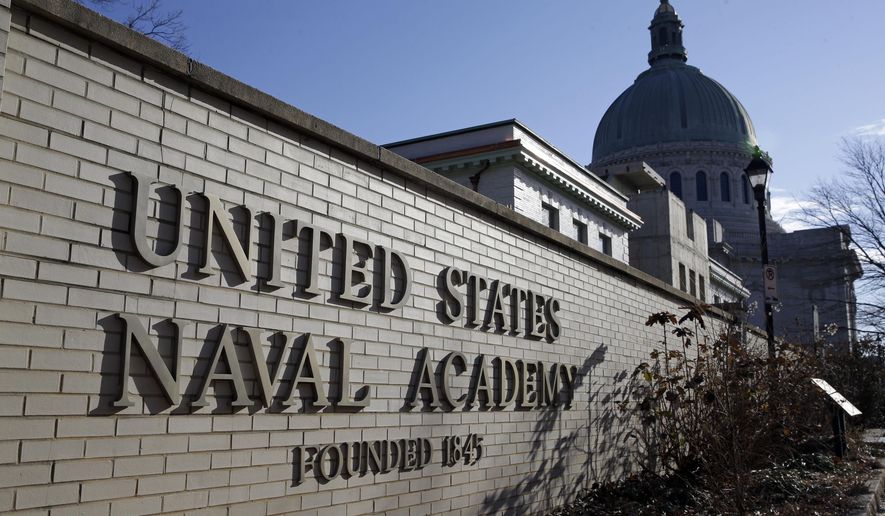ANNAPOLIS, Maryland — It’s oh-dark-thirty at the U.S. Naval Academy and the workday has begun even earlier than usual for the freshman class, known as plebes. The upperclassmen — crusty old military veterans at age 20 — are racing through Bancroft Hall like avenging angels, banging on doors, yelling into megaphones, and blasting rock music.
“Get up! Get up! Let’s go! It’s waiting for you!” they shout at the plebes, who are scrambling into the 2:30 a.m. darkness Tuesday for a round of calisthenics to start the day.
Welcome to Sea Trials — 14 hours of grueling exercises, combat drills and deeply cherished Naval Academy tradition, meant to test the mettle of the class of 2025 one last time before they climb off the lowest rung on the academy ladder.
After two years of restrictions brought on by the COVID-19 pandemic, the annual Sea Trials competition was back in full operation this week. The rigorous team challenge is modeled after the Marine Corps’ Crucible and the Navy’s Battle Stations — enlisted recruit training exercises that mark the culmination of the dreaded boot camp experience.
At the Annapolis grounds of the Naval Academy, the day is filled with events designed to push the plebes to their limits. At one moment, they are linking arms in the river and doing squats in the chilly water. Soon they will find themselves treading water in the pool while keeping their rifles dry over their heads.
Although the Sea Trials were closed to the public, The Washington Times was among a handful of media outlets invited to observe this year’s competition. Led by the academy’s upper class, the daylong grind is designed as a group test rather than an individual exercise to better gauge the plebes’ teamwork skills and reinforce their bonds as a class.
SEE ALSO: Air Force Academy cadets face expulsion, repayment demand over vaccine refusal
“The energy is really high. This is something we’ve been working on,” said Daniel Mullan, 18, a plebe from Long Island, New York. “We can see that all the hard work has been paying off.”
The events were held at several locations on campus and on the main base at Naval Support Activity Annapolis. They included relays, aquatics challenges, land navigation drills, obstacle courses and rucksack runs. There was even a contest to see how fast a plebe can patch a leaky pipe — an important skill for those likely to be spending much of their careers at sea.
At an academy focused on the maritime martial arts, located on the Severn River, it wasn’t surprising that many of the competitions took place along the river’s banks. About 30 plebes from one class pulled on their life jackets, scrambled into a half-dozen rubber boats and began paddling toward a turnaround spot in the river about 300 yards away.
Some teams had clearly been practicing and powered through the competition with ease. Others just wanted to somehow finish and get back onto land.
“There’s a bunch of them who don’t know how to paddle,” said one of the more senior midshipmen watching the raft race.
The plebes were frequently reminded that Sea Trials were a team competition.
“It doesn’t matter how fast that first boat came in. It’s the time of the last boat that counts,” said Morgan Sheehy, 19, a 3rd Class midshipman from Minneapolis.
Bouncing back from COVID-19
Larry Frazier and his fellow 2nd Class midshipmen couldn’t do Sea Trials on campus because, at the time, everyone was hunkering down at home owing to the COVID-19 pandemic. For the 21-year-old, it was an online-only competition in the front yard of his home in San Pedro, California.
“They called it ‘E-Trials,’” he said. “We all did the same exercises, but I do feel like I missed out.”
There was little downtime between the individual competitions. After the raft race, the plebes quickly moved toward the next training event, where they donned combat helmets and flak jackets and crawled on their bellies through a mud-filled trench.
Ryan Basford, 19, of Anthem, Arizona, said he felt “great” after pulling himself out of the muddy ditch. “It’s been long and hard and I’m wet, but this is what I signed up for,” he said.
Sea Trials amounted to something of a bookend for Plebe Summer, the orientation period last year when the class of 2025 arrived in Annapolis. The drills are now more physically demanding than they were last summer, but their classmates are no longer strangers from different parts of the country. They are now friends and shipmates.
“We are all really close. You won’t see any cliques or discord here,” Mr. Mullan said. “You need to work together as a team. You rely on them and they rely on you.”
Fellow plebe Jennifer Luong, 18, said Sea Trials seemed to be more “laid back and chill” than Plebe Summer.
“In Plebe Summer, you’re more ‘locked on’ and everyone’s yelling at you,” said the Loudoun County, Virginia, resident. “I’m definitely more confident now. No matter what, you still have more in you.”
Mr. Mullan said his favorite event during Sea Trials was the endurance course. The course is about 2 miles long, with several hills and obstacles to conquer and a bit of mud to make things interesting.
“It’s just a really good time. You’re chasing after each other, but you’re not racing them, you’re racing ‘with’ them. That’s what makes the difference,” he said.
The next event for the class of 2025 will be the infamous Herndon Monument Climb on Monday. The plebes will scale a 21-foot-tall column on the campus that has been liberally slathered with about 200 pounds of vegetable shortening. After building their own human pyramid, the plebes will attempt to replace a sailor’s “dixie cup” hat with an upperclassman’s hat.
After that, they will be “plebes no more.”
• Mike Glenn can be reached at mglenn@washingtontimes.com.




Please read our comment policy before commenting.